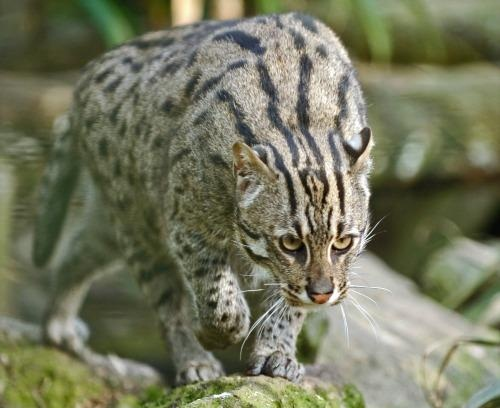Uttarakhand Switch to Hindi
Fishing Cat Collaring Project
Why in News?
- The Wildlife Institute of India-Dehradun is set to launch India’s first Fishing Cat Collaring Project at Coringa Wildlife Sanctuary.
Key Points
- Coringa Wildlife Sanctuary:
- Spanning 235 square kilometres, Coringa Wildlife Sanctuary (CWS) is India’s second-largest mangrove habitat.
- It is home to the endangered fishing cat.
- Located in the Godavari estuary, the sanctuary lies at the confluence of the Coringa River and the Bay of Bengal in Kakinada, Andhra Pradesh.
- Krishna Wildlife Sanctuary in the Krishna estuarine forest area is another habitat for the fishing cat.
- Fishing Cat Population Trends:
- The first fishing cat survey in 2018 recorded a population of 115 individuals.
- Sightings have increased significantly over the past five years, suggesting population growth in and around the sanctuary.
- Mangrove Conservation and Community Role:
- Local communities, through the Environment Development Committees (EDCs), actively conserve the mangrove ecosystem.
- A total of 420 locals are part of the EDCs, which also manage Community-Based Eco-Tourism (CBET) for alternative livelihoods.
- India’s First Fishing Cat Collaring Project:
- The Wildlife Institute of India-Dehradun is executing India’s first Fishing Cat Collaring Project as part of the second fishing cat census.
- This three-year project aims to study the species' home range, behaviour, habitat ecology, feeding habits, and space use.
- The project plans to collar 10 fishing cats with lightweight GIS-equipped devices.
- The collaring is expected to be completed by March or April 2025.
- Ramsar Convention Site Proposal:
- The Andhra Pradesh Forest Department is striving to secure Ramsar Convention Site status for Coringa Wildlife Sanctuary due to its rich biodiversity and ecological significance.
Wildlife Institute of India
- It is an autonomous institution under the Ministry of Environment, Forest and Climate Change.
- It was established in 1982.
- It is based in Dehradun, Uttarakhand.
- It offers training programs, academic courses, and advisory in wildlife research and management.
Fishing Cats
- Scientific Name: Prionailurus viverrinus.
- Description:
- It is twice the size of a house cat.
- The fishing cat is nocturnal (active at night) and apart from fish also preys on frogs, crustaceans, snakes, birds, and scavenges on carcasses of larger animals.
- The species breed all year round.
- They spend most of their lives in areas of dense vegetation close to water bodies and are excellent swimmers.
- Habitat:
- Fishing cats have a patchy distribution along the Eastern Ghats. They abound in estuarine floodplains, tidal mangrove forests and also inland freshwater habitats.
- Apart from Sundarbans in West Bengal and Bangladesh, fishing cats inhabit the Chilika lagoon and surrounding wetlands in Odisha, Coringa and Krishna mangroves in Andhra Pradesh.
- Threats:
- A major threat for fishing cats is the destruction of wetlands, their preferred habitat.
- Shrimp farming is another growing threat to mangrove habitats of the Fishing Cat.
- This unique cat also faces threats from hunting for meat and skin.
- Tribal hunters indulge in ritual hunting practices throughout the year.
- It is also occasionally poached for its skin.
- Protection Status:
- IUCN Red List: Vulnerable
- CITES: Appendix II
- Indian Wildlife Protection Act, 1972: Schedule I


.png)




.jpg)





.jpg)
.jpg)






-2026-web-eng.png)
-2026-mob-eng.png)
.png)


.jpg)



 PCS Parikshan
PCS Parikshan


